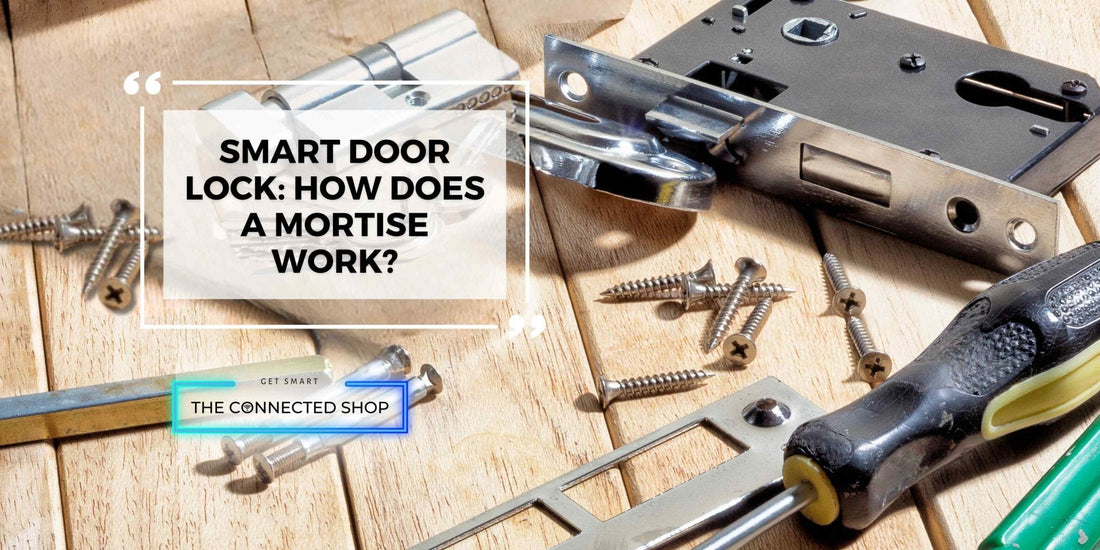With the advent of smart technology, our homes are becoming increasingly connected and intelligent. From thermostats that learn our preferences to voice-activated assistants that control our lighting, the possibilities seem endless. One area where innovation has truly flourished is in home security, particularly with the advent of smart door locks. These modern marvels not only provide convenience but also offer enhanced protection and peace of mind.
Among the various types of smart door locks available, one design stands out for its reliability and robustness: the mortise lock. But what exactly is a mortise lock, and how does it work? In this blog post, we'll delve into the mechanics of the mortise lock, exploring its inner workings and understanding why it's a popular choice for homeowners seeking top-notch security for their abodes. So, let's unlock the mystery and discover the fascinating world of smart door locks and the mechanics behind the mortise.
Introduction to Mortise Smart Locks
Mortise smart locks represent a fusion of the classic mortise lock design with the convenience and intelligence of modern smart home technology. Unlike surface-mounted deadbolts or cylindrical locks, which sit on the surface of the door, mortise locks are installed within the door itself, providing a higher level of security and durability.
The basic components of a mortise smart lock typically include:
Mortise Lock Body: The core of the system, the mortise lock body is installed within the door's mortise pocket, providing the primary locking mechanism.
Cylinder: This component houses the keyway and allows for manual unlocking with a traditional key, providing a backup method of entry in case of power outages or technical issues.
Latch: The latchbolt extends from the lock body and retracts when the door is closed, securing the door in place. In smart mortise locks, this may be motorized for remote locking and unlocking.
Deadbolt: A key component for enhanced security, the deadbolt is a thick, solid bolt that extends deep into the door frame when locked, providing additional resistance against forced entry attempts.

Faceplate: A flat metal plate installed on the edge of a door frame, housing the latch mechanism of a mortise lock and providing a striking plate for the latch bolt to secure the door.
Strike Plate: Installed on the door jamb, the strike plate receives the latchbolt when the door is closed, ensuring a secure lockup.
With these fundamental components working in harmony, mortise smart lock offer a sophisticated blend of security, convenience, and style, making them a popular choice for homeowners looking to upgrade their door security while embracing the possibilities of a connected home.
Functionality of Traditional Mortise Smart Locks
Mortise smart lock represents the pinnacle of home security, combining traditional craftsmanship with modern technological advancements to provide unparalleled protection and convenience. To truly grasp the functionality of these sophisticated devices, it's essential to understand the mechanical workings of a traditional mortise lock, as well as how key and smart door lock systems interact with the lock mechanism.
Traditional Mortise Locks:
A traditional mortise lock consists of several key components that work together to secure a door. At the heart of the system is the mortise lock body, which is installed within the door's mortise pocket. Within the lock body, a series of levers and springs control the movement of the bolt mechanism.
When the correct key is inserted into the lock cylinder and turned, the key's unique pattern aligns the internal components within the lock, allowing the bolt to retract and the door to be unlocked. This mechanical operation has been the cornerstone of door security for centuries, providing reliable protection against unauthorized entry.
Key and Smart Door Lock Interaction:
In a mortise smart lock, the integration of smart technology adds a new layer of functionality to the traditional lock mechanism. While the mechanical components remain largely unchanged, electronic sensors, actuators, and communication modules are added to enable remote access, keyless entry, and other advanced features.
When using a smart mortise lock, homeowners have the option to unlock their doors using a variety of methods, including a traditional key, a keypad code, a fingerprint, a smartphone app, or even voice commands. These commands are transmitted to the lock's electronic components, which then actuate the mechanical mechanisms to unlock the door.
Other Types of Mortise Locks
Multipoint Mortise Locks:
Multipoint mortise locks feature multiple locking points along the length of the door, providing enhanced security and sealing capabilities. These locks are commonly found in high-security applications, such as entrance doors and patio doors. The additional locking points distribute force more evenly, making them more resistant to forced entry attempts.
Sliding Door/Hook Mortise Locks:
Sliding door or hook mortise locks are designed specifically for sliding doors or windows. Instead of a traditional latchbolt, these locks utilize hooks or bolts that engage with the door frame or adjacent panel when locked, providing secure closure and preventing the door from being lifted or forced open. They are commonly used in patio doors, sliding glass doors, and other sliding applications where traditional locks may be less effective.
These different types of mortise locks demonstrate the versatility and adaptability of the mortise design, ensuring that there is a suitable option available for virtually any door configuration or security requirement. Whether it's the time-tested reliability of a traditional mortise lock or the advanced features of a smart-enabled variant, mortise locks continue to be a cornerstone of home security, providing peace of mind and protection for homeowners around the world.

Maintenance and Upkeep of Mortise Smart Locks
Maintaining your mortise smart lock is important for ensuring its longevity and reliability. Start by keeping the exterior clean with a soft, dry cloth to prevent dust buildup. Check battery levels regularly and replace them as needed to avoid operational issues. Stay updated with the latest firmware and software updates to address security vulnerabilities and improve performance. Test remote access features periodically to ensure they're functioning correctly, and troubleshoot any issues promptly. Lubricate moving parts, such as the latchbolt and deadbolt, to prevent friction and ensure smooth operation. Check the alignment of your door regularly to prevent strain on the lock mechanism. Secure your Wi-Fi network to protect against unauthorized access to your lock. Finally, monitor activity logs to keep track of entries and exits and detect any suspicious activity. Following these guidelines will help keep your smart mortise lock in top condition for years to come.
Conclusion
In conclusion, the evolution of smart mortise locks represents a harmonious blend of tradition and innovation in home security. From the classic mechanics of traditional mortise locks to the cutting-edge features of smart technology, these locks offer unparalleled protection and convenience for homeowners. Whether you're drawn to the robust reliability of a traditional mortise lock or the advanced functionality of a smart-enabled variant, there's a solution to fit every security need. By understanding the mechanics of mortise locks and implementing proper maintenance and upkeep, you can ensure that your home remains safe and secure for years to come. So, embrace the possibilities of smart door locks and enjoy the peace of mind that comes with knowing your home is protected by the latest in security technology.




1 comment
Joseph Maryland
Thank you.